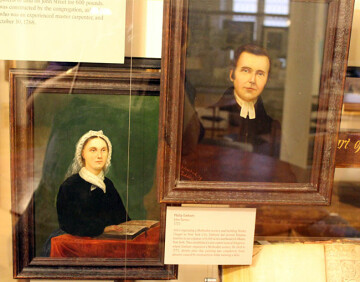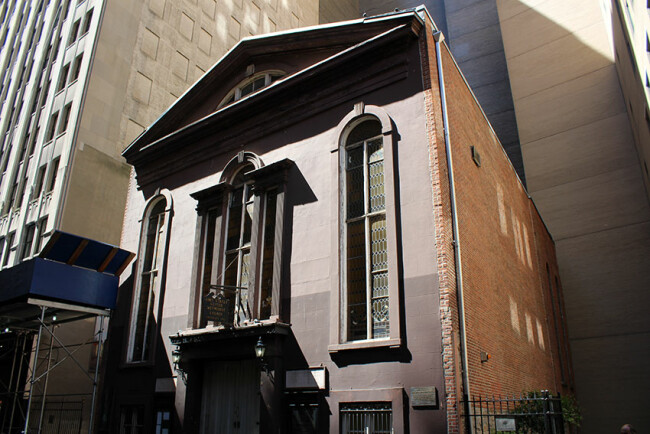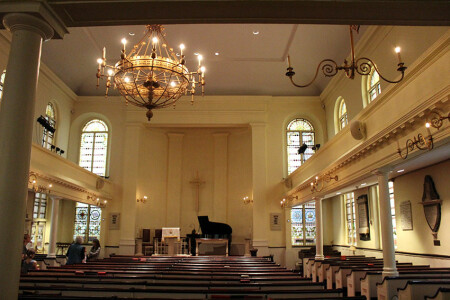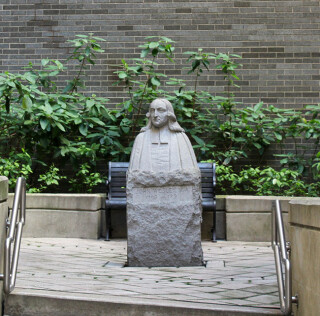Traveling the Circuit: John Street Church, New York
By Rev. Charles Harrell
“Philip, you must preach to us, or we shall all go to Hell together and God will require our blood at your hands!”

Barbara Heck and Philip Embury
Safe to say, this is not a typical reaction to seeing friends playing a hand of cards. Then again, Barbara von Ruckle Heck was not typical, either. A native of the Palatinate (part of the Rhine region in today’s Germany), she and her husband Paul had been part of a wave of German settlers in Ireland before emigrating to America. Arriving in New York City, the Hecks lived amid other German and Irish immigrants, including Philip Embury, a native of County Limerick and also of German extraction. Embury and the Hecks were among those who had been spiritually awakened through the preaching of John Wesley and others in Ireland, and Embury had once been a Methodist preacher in the old country. Though work had been found in New York – Philip taught school – it was an expensive place to live, and the rents were always rising. (Some things never change.) Though they attended Sunday services, Embury and the Hecks found their spiritual edge dulling. So when Barbara Heck came into Philip Embury’s house and found him at cards – a twin sin in the eyes of early Methodists for “trifling away time” and (we should understand) the risking of money by gambling – she was convinced that perdition was just at their elbow. Her answer: “Philip, you must preach to us!”

Embury was not eager to take the task on, and not just because he was holding a winning hand. He had no
And the congregation grew. Part of the draw was Captain Thomas Webb, a British seaman and fiery Methodist preacher who, mounting the pulpit in his crimson uniform and green eyepatch, also brought gifts as a talented organizer and fundraiser. Besides helping the society in New York to organize, he was instrumental in starting St. George’s in Philadelphia as well as aiding fledgling efforts in New Jersey, Delaware, and Maryland. Before long, the little band in New York was renting space to meet, first on Barrack Street (now part of City Hall Park) and then in a loft for ship’s rigging on Horse and Cart Lane (now William Street). By early 1768 the congregation had outgrown the rigging loft; so the church bought two lots on John Street and erected a house of worship. Christened Wesley Chapel, it was the first building in the world named for the Methodist founder, and on 30 October 1768, its first service was held in the first permanent home of America’s first permanent Methodist congregation with about 100 people in attendance. A transatlantic request for help to Mr. Wesley resulted in the dispatching of his first two emissaries to America, Joseph Pilmore and Richard Boardman. They would soon be followed by others, including Francis Asbury, who preached many times at Wesley Chapel and, after 1784, held General Conferences of the newly-established Methodist Episcopal Church there.
During the American Revolution, New York was occupied by British forces from
Racism also plagued the early years at Wesley Chapel, with tensions intensifying after the Revolutionary War. As at St. George’s in Philadelphia, there was a substantial group of black congregants; but unlike the situation in Pennsylvania, none were permitted to preach, though they did have their own class: #31, led by Peter Williams, the sexton for the church. Williams – who had been the slave of a Loyalist or “Tory” – found himself in a strange position after the war; and on his request, the church legally “purchased” him and enabled him to obtain his freedom for $40, which he later repaid. (His son, Peter Williams, Jr., would later become the second African-American Episcopal priest ordained in America, after Absalom Jones in Philadelphia.) The overall picture was grim: black members were relegated to the
 By 1803, Wesley Chapel was being referred to as “Old John Street Church” in Francis Asbury’s journal. In 1817, a second, larger building was erected on the site. But the installation of carpet and other fine finishes in the new building resulted in a schism – carpeting was considered frivolous and a waste of money! – and a large group left the church. The Great Fire of 1835, which destroyed the financial district and much of Lower Manhattan including many of the old buildings from the Dutch colonial period, did not touch the
By 1803, Wesley Chapel was being referred to as “Old John Street Church” in Francis Asbury’s journal. In 1817, a second, larger building was erected on the site. But the installation of carpet and other fine finishes in the new building resulted in a schism – carpeting was considered frivolous and a waste of money! – and a large group left the church. The Great Fire of 1835, which destroyed the financial district and much of Lower Manhattan including many of the old buildings from the Dutch colonial period, did not touch the
Times do change, however, and gradually, most of the churches in what was becoming the ever-expanding city’s financial district moved away. John Street Church remained, however, and experienced its peak period of growth and activity around the time of the Civil War, when about 2,000 persons attended weekly services.
Today, the congregation numbers about 100 on the roll with a weekly attendance of 50-70. Most congregants reside in the neighborhood around the church or a little to the south near Battery Park; many are transplants from other parts of the country, and many are new to church life altogether. Among John Street’s signature ministries
During my visit, I had the privilege of enjoying the final tour led by Rev. Jason Radmacher at the end of his 19-year tenure at John Street. Pastor Jason took us through the museum in the undercroft with its exhibits and displays of historic furnishings and memorabilia, along with the lovely sanctuary upstairs. John Street Church is worthy of a visit by every Methodist. Though it has long ceased to be the tallest or largest building in the neighborhood and could be mistaken for a kind of antiquarian relic in masonry, this church continues to be a vital part of the spiritual life of the city, and a testimony to the spiritual heritage of the nation.
Incidentally, whatever happened to Philip Embury and the Hecks? Embury would relocate to Camden Valley, northeast of Albany, where he worked as a carpenter during the week and preached on Sundays. There he organized the first Methodist society in what would later become the Troy Conference (now the Upper New York Conference), working with other immigrants from Ireland. He died in a farming accident in
Paul and Barbara Heck also moved to Camden Valley. Later, they relocated to Salem, in northeastern New York near Lake Champlain, where they again organized the first Methodist society in the area. They had gone to the Champlain region to be part of a community of “Tories” or United Empire loyalists, opposing American independence. Like other loyalists, they suffered violence and the loss of their property for their views. Paul Heck actually joined the British army under General John
 Allow one hour for your visit to John Street Church and its museum. The church is located in Lower Manhattan at 44 John Street, New York, NY 10038, between Nassau and William Streets, a block and a half east of Broadway. The sanctuary is open for a brief period Monday through Thursday afternoons, and the museum is open by appointment. To arrange a visit, call (212) 269-0014 or email
. There is no charge, though donations are gratefully accepted. A lovely sitting garden belonging to the church lies immediately adjacent, complete with a mural and a bust of John Wesley. Sunday worship is at 11:00 a.m.
Allow one hour for your visit to John Street Church and its museum. The church is located in Lower Manhattan at 44 John Street, New York, NY 10038, between Nassau and William Streets, a block and a half east of Broadway. The sanctuary is open for a brief period Monday through Thursday afternoons, and the museum is open by appointment. To arrange a visit, call (212) 269-0014 or email
. There is no charge, though donations are gratefully accepted. A lovely sitting garden belonging to the church lies immediately adjacent, complete with a mural and a bust of John Wesley. Sunday worship is at 11:00 a.m.
Other places to visit in New York City are of course too numerous to name. The church is about a 15-minute walk from the Netherland Monument at Battery Park and Wall Street. Join the crowd to get your photo with the famous “Charging Bull” and “Fearless Girl” sculptures, or visit the New York branch of the Smithsonian Institute’s National Museum of the American Indian, known as the George Gustav Heye Center. Nearby is Trinity Church (Episcopal) with its marvelous Gothic architecture and stained glass, in whose cemetery rest such notable Americans as Alexander Hamilton (first Secretary of the Treasury) and Robert Fulton (inventor of the steam engine). The church is also a short walk from the new billion-dollar Fulton Center, a transit hub for the MTA that provides easy access to everywhere else in the Big Apple.
John Street Church is also an easy walk from the ferry terminal to Staten Island. Families especially may be interested in the National Park Service campground at Camp Gateway, located at Fort Wadsworth on Staten Island, practically underneath the Verrazano Narrows Bridge and boasting fantastic views of the city. For reservations, go to www.recreation.gov. While you’re there, check out Tony’s Brick Oven on Bay Street in Staten Island for some truly great East coast pizza, at very reasonable prices. The ferry to and from Manhattan is free, and though the parking at the ferry terminal is not, it is quite reasonable. The ferry ride offers great views of the Statue of Liberty, Ellis Island, and of course the Manhattan skyline.
So put your cards down on the table, pack your bag, and journey among the canyons of concrete, glass, and steel to where organized and urban Methodism began in the New World. Perhaps, with a little luck and a bit of grace, you’ll hear the echo of a feminine voice, with a German accent and the hint of an Irish lilt, recalling you to Scriptural holiness and vital piety.
Rev. Charles L. Harrell, Ph.D., is a retired elder in the Baltimore-Washington Conference. When not working at his day job as Director of Pastoral Care for a fabulous area retirement community or teaching in the field of history and doctrine at one of our United Methodist seminaries, he can often be found poking around sites of historical or cultural interest. His not-so-hidden agenda is to incite or fan a similar flame of appreciation for our heritage in faith and its gifts and promise for blessing now and tomorrow.
